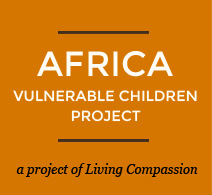Glimpsing the line of water containers as we drive through the Living Compassion gate this morning, we can tell immediately that the water is off in Kantolomba again. There is much gratitude that the local community and beyond has a reliable, clean source of water at the Living Compassion property. Theresa tells us that when there are large areas without water, people arrive as early as 3:00am to queue up for water!

Another artful water queue.
As we park, dozens of children come to greet us and watch themselves in the reflection on the car doors. It is fun to see their expressions change and their faces light up when they recognize themselves!

Which one is me?

Balancing water jugs in training.

We are greeted by more gorgeous, smiling faces.
It is easy to stop seeing the simple beauty of the property as we settle into a daily routine of the program, but this morning, walking over towards the preschool English, we see anew the picturesque building with the garden in the yard lit by the morning sun.

The path to the preschool

One of the "relishes" (side dish) the team serves with nshima is pumpkin leaves, seen here growing in this garden.
Yesterday afternoon we stopped to pick up notebooks that Phil will use to put the materials together for the teacher manuals for Veronica and Beatrice. It is clear that Joy has been doing a wonderful job over this last year. The longer we are with the children, the deeper we realize their English has rooted. It can seem so simple that when we give an instruction such as, "Please line up to wash your hands" they do it, but then when we realize there is not a single string of words someone could say to us in Bemba that we could understand, we remember just how huge it is! And that they can interact with us! For example, when they are eating their lunch we can ask, "What are you doing?" "I am eating nshima." "Do you like nshima?" "Yes, I like eating nshima." Wahoo!
So, the next phase is to train Veronica and Beatrice to use this same methodology. The plan is to get them used to this new English program, and when the new school year starts in January, when many of our preshoolers head to grade 1, Beatrice and Veronica will jump in and begin English tutoring for grades 1-4. Currently, once a child is old enough to go to grade 1, they leave the preschool but return to Living Compassion each day to eat lunch. Getting several teachers trained in this program will mean we can offer tutoring to quite a number of children when they come for lunch. Very exciting.

Phil prepares for the day ahead in the pre-school classroom, putting together the teacher training materials.
(The Living Compassion team wears a different color each day of the week. Thursday is blue. We remembered to wear blue today in solidarity with the team!)
Anna continued to work with Charles on English skills. Charles is learning new tools so that he can teach them to others in the community. We started with a coaching session on ways we can use a voice recorder to practice English. Charles recorded himself repeating one of the sentences we've been using to help us get a feel for the music of English: "How do you spell EAsy?" Yesterday we worked quite a bit on making sure to pronounce "h's" which often get swallowed in Zambian English—"her" becomes "er." He listened back to the recording and hears that on the first go he pronounces the "h" in "how" but then drops it for the rest of the recording. He records again, paying close attention to making the "h" sounds. He listens back and is able to hear how what he is saying sounds clearer and easier to understand in the second recording. Yea for recording and listening—very broad application!
Soon, Theresa and Jen joined in, and we looked at ways to structure the English program so that we can tap into the rich resources we have in the project. An important part of this will be to have Charles teaching as much as he can through the day to different groups of students. And we are looking at putting in place a thirty-minute English class every day for the strongest English speakers on the team, the group we met with on Saturday. The vision is for them to take turns teaching this class. More on these plans to follow as they unfold...
To familiarize ourselves with the textbook materials the adult team will be using, we did the exercises together. We read an inspiring article about a young man in India who attended a fee-paying school that other families in his community could not afford. At age 14 the young man began passing on what he was learning in school to other young, less fortunate people in the community, 8 of his friends at first. Now, at the age of 16, he is head teacher of a school of 650 students! Theresa and Charles talked about how this story reminds them of their own experience in Kantolomba: Theresa tells us how she began feeding 20 children in her yard, and now the project feeds 800 children a day. They said they can understand the young man's motivation: love for his community, and a desire to serve. We all agreed that when it comes from someone's heart, an effort like this young man is making becomes sustainable. The heart is a bottomless well of energy and desire to participate!
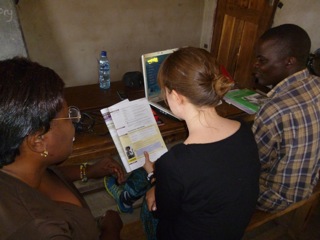
Theresa, Anna, Charles.
Soon it is time for lunch...
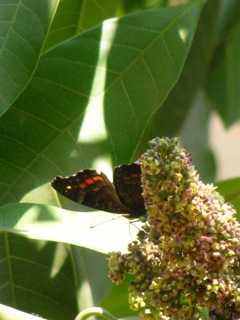
A beautiful visitor joins us for lunch. A perfect symbol of the transformation all around us!
Imagine that as all of this English work is happening, there is a group of tireless women out there stirring, cooking, and dishing out food for 800 children who come through in a steady stream all day long!
Theresa continues to practice her photography. We nominated these three photos as some of the best among today's shots!
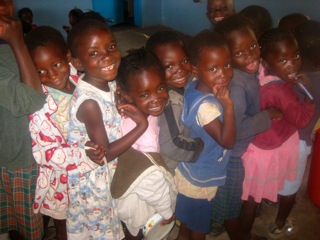
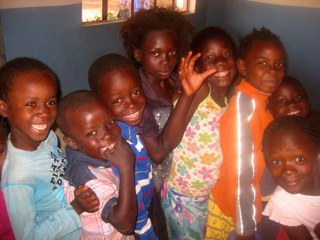
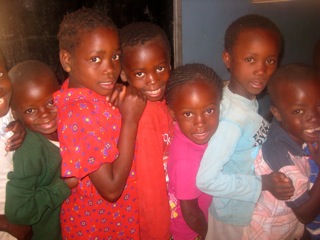
A joy-filled gallery of lunchtime smiles:

Little Theresa has gotten so big!
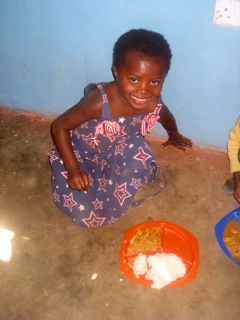

Can you really eat all that nshima?!



Perhaps you remember little Deborah (also called Docus) on the left. She was a tiny baby on our summer 2008 trip. We were all enthralled by how responsive she was at such a young age. She is as sweet as she could be! Check it out
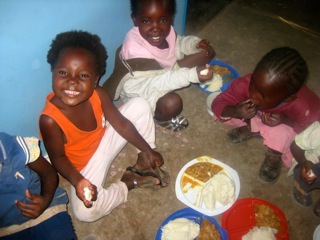
Ronika, in orange, is JoAnn and Ruben's daughter.
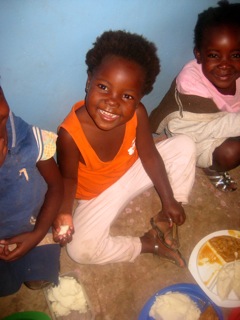
We held another high-energy, action-packed reading session with the young women. There were so many of them that we were not quite sure how to engage them all. We decided on a plate-spinning strategy—we would get this group going on this book, then move to this group and start on this book… But, as soon as we settled in with the first group, we realized that within a few minutes the rest of those present had organized themselves into groups with their books and began helping each other! Another wahoo! It is a great reminder how modeling is a huge part of everything. We can think we need to directly "teach" something or show someone or…. But, in fact, simply getting the process started, modeling what is possible, those who are paying attention, those who 'want it' will mimic what you are doing and begin to have a first-hand experience of discovering for themselves. It is thrilling!

Reading in unison.
We can send only very short videos back, but we feel it magically brings the project to life to show you some action. Hope you enjoy.

One of the most popular books.
Twaibu has taken a keen interest in all the reading. It turns out he is our strongest reader yet! Wow. That's exciting.
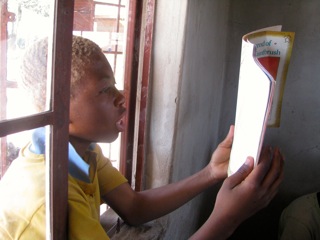
Twaibu reads through the window
Meanwhile, over in the sewing room, work continues swiftly and skillfully on the new Pantolombas...

Chitenge art
After lunch, we sit down with Theresa and Veronica for another internet session. Today, we google "Kantolomba" and find a satellite view of the area on Google maps. We find "Kantolomba" marked and all cheer. Wait, soon we realize THAT is not Kantolomba! The mapmakers do not know our area.
Through an impressive feat of teamwork, we navigate up and down and left to right using landmarks we recognize and close in on Kantolomba. Okay, if the stream is there… and Twapia is over there… then down a little, more to the left… Yes—Kantolomba!! And, suddenly, all of us at once we see it—the Living Compassion roof! Now THAT is fun! There are high-fives all round. Veronica takes the controls and navigates around the satellite view of Kantolomba to find her house; that was a bit harder. All the house roofs start to look the same.
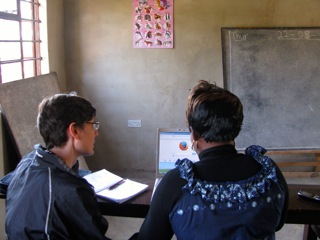
We begin at the beginning—how to open the internet browser and get to Google.
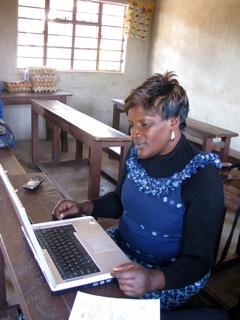
Studying the map

Typing is a big part of the learning!

On the way out of Kantolomba we see a tractor grading the road!! Yea. The government voted in about a year ago has made road improvement a big part of the agenda. We are grateful, for the better roads and for a trillion other things it would take us weeks to enumerate. We know you can relate! More tomorrow…
